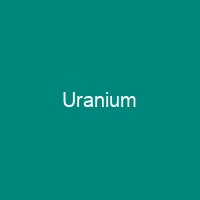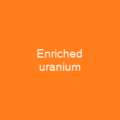Uranium: The Mysterious Metal with a Rich History
Imagine a metal that has been around since the dawn of time, yet its full potential was only unlocked in the 20th century. That’s uranium, the element with the symbol U and atomic number 92. How can such an ancient substance hold so many secrets?
The Basics
Uranium is a silvery-grey metal that belongs to the actinide series of the periodic table. With 92 protons and electrons, it’s no wonder this element has fascinated scientists for centuries. Its unique nuclear properties make uranium one of the most intriguing elements on Earth.
Natural Abundance and Extraction
Uranium is found in low concentrations in soil, rock, and water, making it a naturally occurring element. But how did humans first discover its presence? The story begins with Martin Heinrich Klaproth, who isolated uranium from pitchblende in 1789. Later, Eugène-Melchior Péligot successfully isolated the metal itself in 1841.
Radioactivity and Scientific Discoveries
The discovery of uranium’s radioactivity by Henri Becquerel in 1896 marked a turning point. What other secrets did this element hold? Uranium-235, the isotope used in nuclear weapons and power plants, was discovered through experiments with neutrons in 1934.
Applications of Uranium
The uses of uranium are vast. From nuclear power plants that generate electricity to nuclear weapons that changed warfare forever, this element has played a pivotal role in both peaceful and military applications. Its ability to undergo fission makes it invaluable for producing fissile plutonium-239, which is used in the production of atomic bombs.
Historical Milestones
The Manhattan Project, launched during World War II, was a monumental effort that led to the first artificial self-sustained nuclear chain reaction. How did this project change the course of history? The development of two types of atomic bombs—Little Boy and Fat Man—marked a new era in warfare.
Natural Occurrence and Production
Uranium is more plentiful than antimony, tin, cadmium, mercury, or silver. Its natural abundance makes it a valuable resource for various industries. The majority of uranium production comes from Kazakhstan, followed by Canada, Australia, Russia, and other countries. Mining methods include open pit, underground, in-situ leaching, and borehole mining.
Environmental Concerns
The use of uranium raises significant environmental concerns. How does exposure to uranium affect human health? Occupational Safety and Health Administration (OSHA) has set permissible exposure limits for uranium in the workplace. Ingestion or inhalation can lead to bioaccumulation in bone tissue, causing various health issues.
Future Prospects
The future of uranium looks promising as it continues to play a crucial role in nuclear energy and technology. Will we see new applications for this versatile element? With ongoing research and development, the potential uses of uranium are endless.

In conclusion, uranium is a fascinating element with a rich history and diverse applications. From its discovery in the 18th century to its role in modern nuclear technology, this metal continues to captivate scientists and engineers alike. As we explore new ways to harness its power, one thing is certain: uranium will remain an integral part of our technological landscape for years to come.
You want to know more about Uranium?
This page is based on the article Uranium published in Wikipedia (retrieved on February 25, 2025) and was automatically summarized using artificial intelligence.







